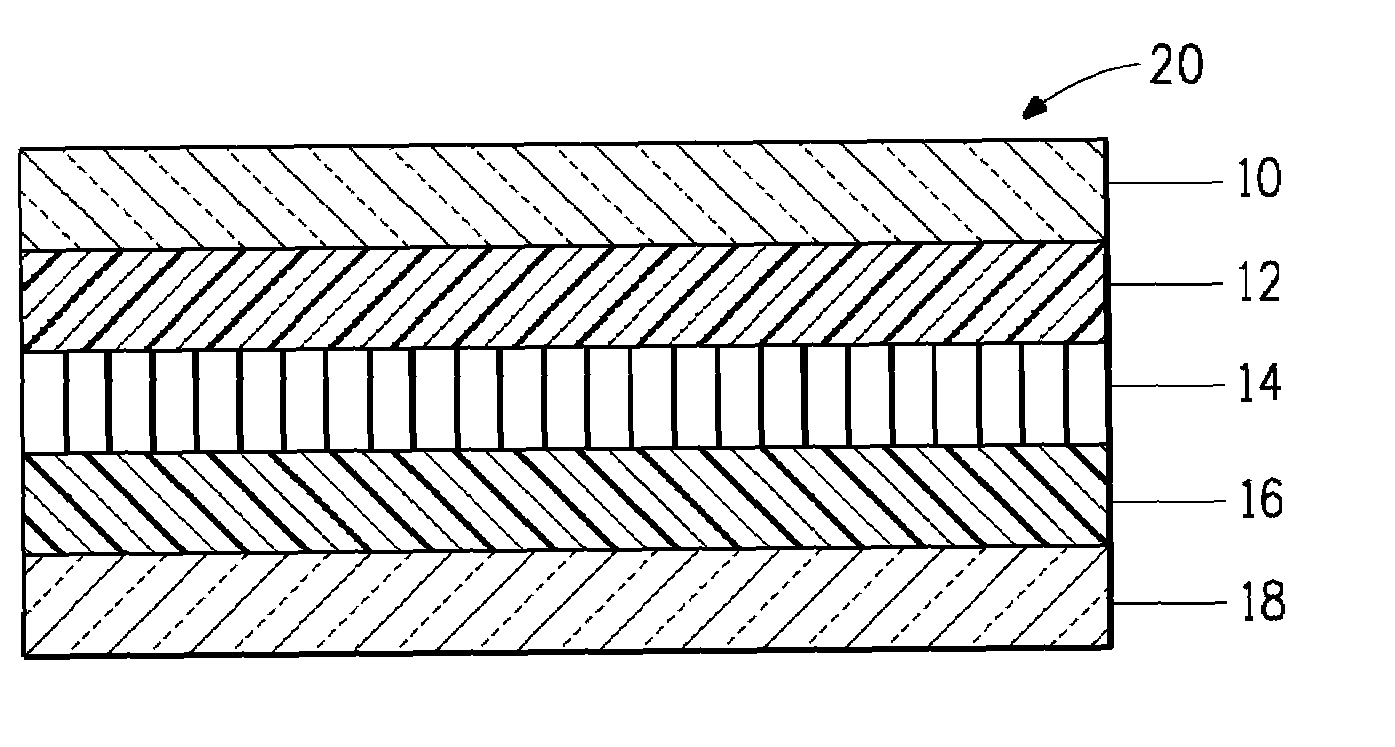Solar cell modules comprising an encapsulant sheet of a blend of ethylene copolymers
a technology of ethylene copolymer and solar cell, applied in the field of solar cell modules, can solve the problems of substantial cost and process concerns
- Summary
- Abstract
- Description
- Claims
- Application Information
AI Technical Summary
Benefits of technology
Problems solved by technology
Method used
Image
Examples
examples
[0082]The following polymer materials were used in the examples:[0083]EMA-1—an ethylene / methyl acrylate copolymer comprising 20 wt % of copolymerized units of methyl acrylate, based on the total weight of the copolymer, and having a melt flow rate of 8 g / 10 min, as determined in accordance with ASTM D1238 at 190° C. and 2.16 kg;[0084]EMA-2—an ethylene / n-butyl acrylate copolymer comprising 27 wt % of copolymerized units of n-butyl acrylate, based on the total weight of the copolymer, and having a melt flow rate of 4 g / 10 min, as determined in accordance with ASTM D1238 at 190° C. and 2.16 kg;[0085]EMA-3—an ethylene / methyl acrylate copolymer comprising 24 wt % of copolymerized units of methyl acrylate, based on the total weight of the copolymer, and having a melt flow rate of 2 g / 10 min, as determined in accordance with ASTM D1238 at 190° C. and 2.16 kg.[0086]E / MAME-1—an ethylene / monoethyl maleate copolymer comprising 9.5 wt % of copolymerized units of the monoethyl ester of maleic ac...
examples e16 and e17
[0108]In E16, a two-layer laminate comprising a 10 mil (0.25 mm) thick press molded film of ECP-1 and a 5 mil (0.051 mm) thick DuPont Kapton® film were made by pressing the two films for 30 seconds at 140° C. under 100 psi (0.689 MPa) in a pre-heated press. Using an Instron tester (Instron Tensile Tester Model 1122) the ECP-1 film was peeled away from the Kapton® film at a 180° angle and a 12.7 cm / min rate, and the peel load was recorded as 4.5 lb / in.
[0109]In E17, a two-layer laminate with the same structure of that in E16 was prepared similarly, except that the films were pressed together at 160° C., and the peel load was recorded as 5.2 lb / in.
Examples E18-E37
[0110]12×12 in (305×305 mm) solar cell modules described in Table 4 are prepared following either lamination process 1 (E18-E27) or lamination process 2 (E28-E37), as outlined below. Layers 1 and 2 constitute the incident layer and the front encapsulant layer, respectively, and Layers 4 and 5 constitute the back encapsulant la...
PUM
| Property | Measurement | Unit |
|---|---|---|
| melt flow rate | aaaaa | aaaaa |
| wt % | aaaaa | aaaaa |
| wt % | aaaaa | aaaaa |
Abstract
Description
Claims
Application Information
 Login to View More
Login to View More - R&D
- Intellectual Property
- Life Sciences
- Materials
- Tech Scout
- Unparalleled Data Quality
- Higher Quality Content
- 60% Fewer Hallucinations
Browse by: Latest US Patents, China's latest patents, Technical Efficacy Thesaurus, Application Domain, Technology Topic, Popular Technical Reports.
© 2025 PatSnap. All rights reserved.Legal|Privacy policy|Modern Slavery Act Transparency Statement|Sitemap|About US| Contact US: help@patsnap.com


